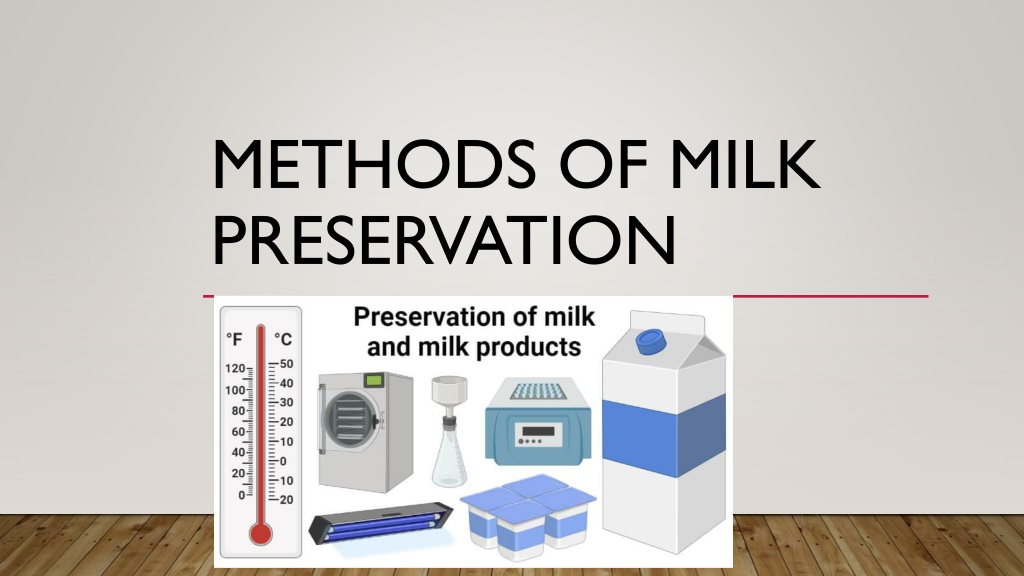

0 likes | 117 Views
Various methods of milk preservation are utilized to hinder the growth of spoilage-causing microorganisms and maintain milk's nutritional properties. These methods include heat treatment like thermisation and pasteurization, sterilization, dehydration, use of preservative agents, and low-temperature treatment. Each method serves to extend the shelf life of milk products by reducing microbial growth and preserving the quality of the dairy products.

E N D
METHODS OF MILK PRESERVATION
• Milk and its products consist of numerous nutrient content, it serves as an excellent growth medium for all of the microorganisms. Thus, various preservation methods are used to eliminate the growth of spoilage-causing microorganisms and maintaining the nutritional properties of milk. Several techniques have been used to limit the growth of organisms in milk and milk products. •
A. HEAT TREATMENT METHODS • 1. Thermisation • It is the most commonly used method used for milk preservation by heating the milk at a mild temperature at 57 – 68 °C for 15 – 20 seconds and rapidly cooling at <6 °C. This method is effective against spoilage-causing bacteria however it doesn’t eliminate the pathogens such as L. monocytogenes. The main objective of thermisation is to reduce the growth of psychrotrophic bacteria and extend the shelf-life of milk.
• 2. Pasteurization • Pasteurization is a method of food preservation that involves the application of heat, usually below 100° at a certain time. It aims to reduce the number of viable pathogens and spoilage-causing microorganisms (e.g., Coxiella burnettii, Brucella abortis, Mycobacterium tuberculosis) to extend the shelf-life of milk without harming the milk quality. In milk, thermoduric species such as Micrococcus spp., Enterococcus faecium and Enterococcus faecalis, Bacillus subtilis, Bacillus cereus, and certain lactobacilli. are killed by the process of pasteurization. • Four common types of milk pasteurization vary with temperature and time the milk is held at that temperature. 1. Vat Pasteurization/Low temperature, long-time pasteurization in which the milk is heated at 63°C for 30 min. 2. High Temperature/Short Time (HTST) in which, the milk is heated at 72°C for 15 s. 3. Ultra-pasteurization (UP) in which the milk is heated at 138°to 150° C for one or two seconds 4. Ultra-High-Temperature (UHT) in which the milk is heated at 280° F for only two seconds. • The objective of pasteurization are: • To destroy pathogenic organisms present in milk. • To ensure the quality of milk and milk products. • To destroy the unwanted organisms present in milk and milk products.
• 3. Sterilization or UHT • Sterilization is a method of food preservation that involves the application of heat, usually more than 100° at a certain time to kill almost all bacteria followed by packaging in air-tight containers either before or after heat treatment. The sterilized milk can be stored at room temperature for a longer period. • There are two methods of sterilization. 1.Conventional method / In-bottle sterilization method in which the product is packed before heat treatment and the packed product is heated at 105-110°C for 30-45 min. 2.UHT method / Aseptic method in which the product is heated at 135-150°C for 1-20 seconds followed by instant aseptic filling into sterile containers.
• 4. Dehydration • It is defined as the process of removal of water normally present in milk by the application of heat under controlled conditions by evaporation. In this method, the water activity of milk is reduced to prevent the growth of spoilage-causing microorganisms. • The objective of this methods are: • To reduce the growth of spoilage-causing and pathogenic organisms and extend the shelf-life of milk. • To reduce the volume and weight of milk without compromising the nutritive value.
• The methods of dehydration used in milk preservation are: • 1-spray drying • 2-drum drying • 3-fluid bed drying
• 5. Use of preservative agents • Preservatives are substances that are capable of inhibiting or retarding the growth of microorganisms. Such preservatives used in food can be divided into three types: 1.Natural preservatives 2.Bio preservatives 3.Chemical preservatives
• B. Low-temperature treatment • The foods are stored at temperatures 0–5 °C. • It causes minimal changes to the nutritional properties of food. • The main objective of chilling is to reduce the rate of microbial growth and its enzymatic activities which extends the shelf life of milk and milk products. • It has been used in combination with other methods of food preservations such as irradiation, pasteurization to extend the shelf life of milk and milk products. • Milk, cheese, yogurt, butter, etc. are stored in chilled storage. •